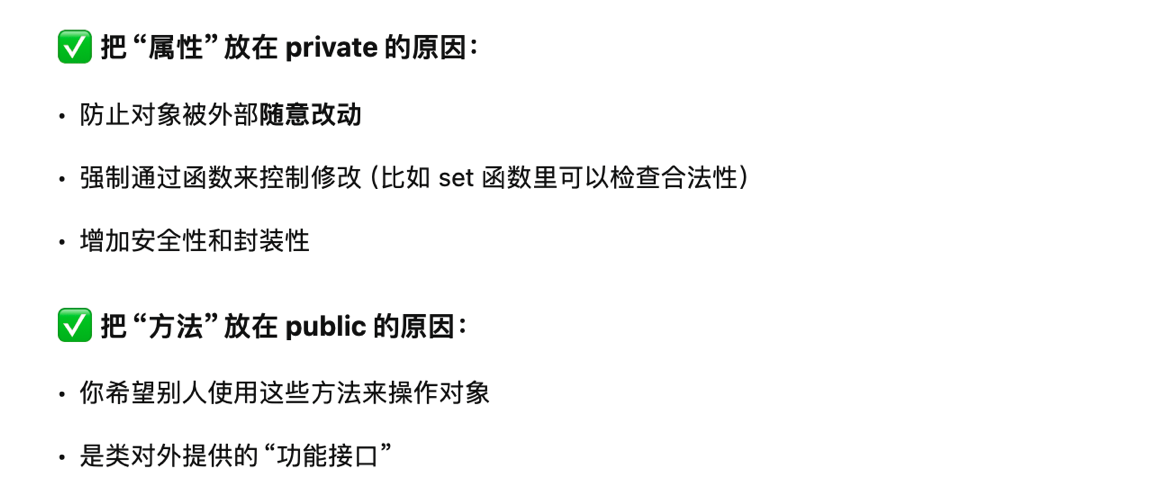首先的话解释一下什么是类吧
1
2
3
4
5
| class student {
string name;
int age;
};
|
就是带class的关键字,里面的姓名和年龄就是类的成员数据,也叫做属性,其实和C的结构体是差不多的
类中的publick和private
- publick里面的成员是可以在类的外部进行访问的
- private里面的成员是不用在类的外部访问的
先看如下代码
1
2
3
4
5
6
7
8
9
10
11
12
13
14
15
16
17
18
| #include <string>
#include <iostream>
using namespace std;
class student {
public:
string name = "Alice";
private:
int age = 18;
};
int main(){
student aa;
cout << aa.name << endl;
return 0;
}
|
再看
1
2
3
4
5
6
7
8
9
10
11
12
13
14
15
16
17
18
19
20
21
22
23
24
25
26
27
28
| #include <string>
#include <iostream>
using namespace std;
class student {
public:
void print_name();
private:
void print_age();
};
void student :: print_name(){
print_age();
cout << "公有" << endl;
}
void student :: print_age(){
cout << "私有" << endl;
}
int main(){
student aa;
aa.print_name();
return 0;
}
|
这边其实就是private对类外部隐藏类内部的工作机制,只能在类里面看到,也就是封装性
但不是说私有方法就无法被调用了,可以通过公有方法来调用
其实上面写法都是不正规的,
重载
成员函数的重载是指一个类中可以有重名名的,但是参数不同的函数
看如下代码
1
2
3
4
5
6
7
| class student {
string name = "Alice";
int age = 18;
bool set(int a);
bool set(string a);
};
|
编译器是可以区分这两个函数的,根据传入的参数类型而选择调用哪个函数
构造函数
- 构造函数就是当你创建类的对象的时候会自动调用
- 构造函数的名字必须和类的名字相同
- 不需要声明是什么类型,也就是没有返回值,连void也不能写
1
2
3
4
5
6
7
8
9
10
11
12
| class student {
string name = "Alice";
int age = 18;
student(){
name = "Bob";
age = 16;
}
};
|
这样就省去了手动初始化的过程,创建对象的时候就能直接初始化
也可以在类外定义构造函数,格式如下
1
2
3
4
5
6
7
8
9
10
11
12
13
| class student {
string name = "Alice";
int age = 18;
student();
};
student :: student(){
name = "Bob";
age = 16;
}
|
有的是类内声明构造函数,类外实现
1
2
3
4
5
6
7
8
9
10
11
12
| class student {
public:
string name = "Alice";
int age = 18;
student();
};
student :: student(){
name = "Bob";
age = 16;
}
|
当然构造函数也是支持重载的,会根据实例化的情况决定调用哪个构造函数
1
2
3
4
5
6
7
8
9
10
11
12
13
14
15
16
17
18
19
20
21
22
23
24
25
26
27
| #include <string>
#include <iostream>
using namespace std;
class student {
public:
string name = "Alice";
int age = 18;
student();
student(int a, int b);
};
student :: student(){
name = "Bob1";
}
student :: student(int a, int b){
name = "Bob2";
}
int main(){
student aa;
cout << aa.name << endl;
student bb(5, 3);
cout << bb.name << endl;
return 0;
}
|
- 如果类中没有定义手动定义构造函数,编译器会自己生成一个无参数的构造函数
- 但如果你定义了构造函数,就不会生成
具体可以看如下的代码
1
2
3
4
5
6
7
| class A {
};
int main() {
A a;
}
|
1
2
3
4
5
6
7
8
| class A {
public:
A(int x) {}
};
int main() {
A a;
}
|
编译器不会帮你生成 A(),因为你自己写了构造函数,它认为你要自定义构造方式。
析构函数
析构函数主要是销毁对象,释放内存数据
看如下代码
1
2
3
4
5
6
7
8
9
10
11
12
13
14
15
16
17
18
19
20
21
22
23
24
25
26
| #include <string>
#include <iostream>
using namespace std;
class student {
public:
string name = "Alice";
int age = 18;
student();
~student();
};
student :: student(){
name = "Bob1";
}
student :: ~student(){
cout << "删除完成" << endl;
}
int main(){
student *p = new student();
delete p;
return 0;
}
|
释放内存实际上是delete的作用
调用delete后
所以比如说你直接调用析构函数是不能起到释放内存资源的作用的
而局部对象(非new创建)是在生命周期结束后自动调用析构函数
1
2
3
4
5
6
7
8
9
10
11
12
13
14
15
| #include <iostream>
using namespace std;
class student {
public:
student() { cout << "构造函数被调用" << endl; }
~student() { cout << "析构函数被调用" << endl; }
};
int main() {
cout << "进入 main()" << endl;
student s;
cout << "即将结束 main()" << endl;
return 0;
}
|
输出
1
2
3
4
| 进入 main()
构造函数被调用
即将结束 main()
析构函数被调用
|
扩展知识点
还有一种是例如static int a = 5;或者是字符串常量,这种既不放在堆,也不放在栈,而是放在静态/全局数据段
常成员函数const
使用const修饰的函数实现只允许读数据,不允许修改数据,主要是为了防止误操作
看如下代码
1
2
3
4
5
6
7
8
9
10
11
12
13
14
15
16
17
18
19
20
21
22
23
24
25
26
| #include <string>
#include <iostream>
using namespace std;
class student {
public:
string name = "Alice";
int age = 18;
void read() const;
};
void student :: read() const{
cout << name << endl;
}
int main(){
student *p = new student();
p -> read();
delete p;
return 0;
}
|
输出
静态成员static
如果在类中定义定义了静态成员变量,那么他在类中是通用的,也就是不管你实例化了多少个对象,所有对象对应的静态变量是公用的
- 注意类内只能声明,然后类外才能初始化
- 初始化的时候不需要带static
1
2
3
4
5
6
7
8
9
10
11
12
13
14
15
16
17
18
19
20
21
22
23
24
25
26
27
28
29
30
31
32
33
| #include <string>
#include <iostream>
using namespace std;
class student {
public:
string name = "Alice";
int age = 18;
student();
static int cnt;
};
int student :: cnt = 0;
student :: student(){
cnt += 1;
}
int main(){
student *p = new student();
student aa;
student bb;
cout << aa.cnt << endl;
cout << bb.cnt << endl;
cout << student :: cnt << endl;
delete p;
return 0;
}
|
类的派生继承
其中父类也叫基类、超类
子类也叫派生类
具体看如下的代码
1
2
3
4
5
6
7
8
9
10
11
12
13
14
15
16
17
18
19
20
21
22
23
24
25
26
27
28
29
30
31
32
33
34
35
36
37
38
39
40
41
42
43
44
| #include <string>
#include <iostream>
using namespace std;
class student {
public:
int age = 7;
void print_name();
private:
string name = "lin";
void print_age();
};
void student :: print_name(){
print_age();
cout << "公有" << endl;
}
void student :: print_age(){
cout << "私有" << endl;
}
class undergraduate : public student {
public:
string course;
};
class postgraduate : public student {
public:
string research;
};
int main(){
undergraduate aa;
cout << aa.age << endl;
return 0;
}
|
-
类可以对继承来的父类方法进行重写,这是运行时多态的体现
-
子类没有自己的构造函数时,会调用父类的构造函数(只能调用无参数的构造函数,带参数的是不行的)
-
当然子类也可以有自己的构造函数,构造函数同样可以无参数,也可以带参数
-
子类并不是继承了父类的构造函数
-
子类实例化对象的时候,是先调用父类的构造函数,再调用子类的构造函数
一样看代码
1
2
3
4
5
6
7
8
9
10
11
12
13
14
15
16
17
18
19
20
21
22
23
24
25
26
27
28
29
30
31
| #include <string>
#include <iostream>
using namespace std;
class student {
public:
int age = 7;
void print_name();
student(){
age = 8;
}
};
class undergraduate : public student {
public:
string course;
undergraduate(){
cout << age << endl;
age = 9;
}
};
int main(){
undergraduate aa;
cout << aa.age << endl;
return 0;
}
|
输出
再看如下代码
1
2
3
4
5
6
7
8
9
10
11
12
13
14
15
16
17
18
19
20
21
22
23
24
25
26
27
28
29
30
| #include <string>
#include <iostream>
using namespace std;
class student {
public:
int age = 7;
void print_name();
student(int a){
age = 8;
}
};
class undergraduate : public student {
public:
string course;
undergraduate(int a) : student(a){
cout << age << endl;
age = 9;
}
};
int main(){
undergraduate aa(5);
cout << aa.age << endl;
return 0;
}
|
这边的显示指定,也不说两个构造函数的参数必须一样,而是父类里面的参数必须是存在的,有来源依据的才行
隐藏
- 当子类和父类拥有相同的同名的函数的时候,父类的会被隐藏,无法直接调用,除非显示指定了
具体还是看代码
1
2
3
4
5
6
7
8
9
10
11
12
13
14
15
16
17
18
19
20
21
22
23
24
25
26
27
| #include <string>
#include <iostream>
using namespace std;
class student {
public:
int age = 7;
void print_name(int a){
cout << "111" << endl;
}
};
class undergraduate : public student {
public:
string course;
void print_name(string a){
cout << "222" << endl;
}
};
int main(){
undergraduate aa;
return 0;
}
|
当然也可以解除隐藏
1
2
3
4
5
6
7
8
9
10
11
12
13
14
15
16
17
18
19
20
21
22
23
24
25
26
27
28
| #include <string>
#include <iostream>
using namespace std;
class student {
public:
int age = 7;
void print_name(int a){
cout << "111" << endl;
}
};
class undergraduate : public student {
public:
using student :: print_name;
string course;
void print_name(string a){
cout << "222" << endl;
}
};
int main(){
undergraduate aa;
aa.print_name(1);
return 0;
}
|
protected关键字
现在了解完类的派生继承之后,可以来了解这个protected了
- protected在没有派生继承的情况下,他的作用和private是一样的
但如果有派生继承的情况下
- 公有继承的时候,父类中除了public被继承,protected也会被继承(继承到子类中的protected),但是只能在类中使用,类外还是无法访问的
具体看如下的代码片段
1
2
3
4
5
6
7
8
9
10
11
12
13
14
15
16
17
18
19
20
21
22
23
24
25
26
27
28
29
30
31
32
33
34
35
36
37
38
39
40
41
42
| #include <string>
#include <iostream>
using namespace std;
class student {
public:
int age = 7;
void print_name();
private:
string name = "lin";
void print_age();
protected:
int iq = 77;
};
class undergraduate : public student {
public:
string course;
void test(){
cout << iq << endl;
}
};
class postgraduate : public student {
public:
string research;
};
int main(){
undergraduate aa;
cout << aa.age << endl;
return 0;
}
|
其实继承如果可以分为如下的几种

所以在保密优先级上,private最私密,protected其次,public最公开,private是无论如何都不能被继承的
类的指针
类也是有指针的
有两种写法
第一种
1
2
3
4
5
6
7
| int main(){
student *p;
student aa;
p = &aa;
p -> print_name(1);
return 0;
}
|
第二种
1
2
3
4
5
| int main(){
student *p = new student;
p -> print_name(1);
return 0;
}
|
具体还是看代码
1
2
3
4
5
6
7
8
9
10
11
12
13
14
15
16
17
18
19
20
21
22
23
24
25
26
27
28
29
30
31
32
33
34
35
36
37
38
| #include <string>
#include <iostream>
using namespace std;
class student {
public:
int age = 7;
void print_name(int a){
cout << "111" << endl;
}
};
class undergraduate : public student {
public:
using student :: print_name;
string course;
void print_name(string a){
cout << "222" << endl;
}
};
int main(){
student *p1;
undergraduate *p2;
student aa;
undergraduate bb;
p1 = &aa;
p1 = &bb;
p2 = &bb;
return 0;
}
|
多态与虚函数
- 加关键字virtual表示这是一个虚函数,写在声明的时候,类外实现的时候不需要写
1
2
3
4
5
6
7
8
9
10
11
12
13
14
15
16
17
18
19
20
21
22
23
24
25
26
27
28
29
30
31
32
33
34
35
36
37
38
39
40
41
42
43
44
45
| #include <string>
#include <iostream>
using namespace std;
class student {
public:
int age = 7;
virtual void print_name();
};
void student :: print_name(){
cout << "111" << endl;
}
class undergraduate : public student {
public:
virtual void print_name(){
cout << "222" << endl;
}
};
class postgraduate : public student {
public:
virtual void print_name(){
cout << "333" << endl;
}
};
int main(){
student *p;
student aa;
undergraduate bb;
postgraduate cc;
p = &aa;
p -> print_name();
p = &bb;
p -> print_name();
p = &cc;
p -> print_name();
return 0;
}
|
加了virtual才能支持多态和重写,不加virtual就只能隐藏
1
2
3
4
5
6
7
8
9
10
11
12
| class Base {
public:
virtual void f() { cout << "Base::f" << endl; }
};
class Derived : public Base {
public:
void f() override { cout << "Derived::f" << endl; }
};
Base* p = new Derived();
p->f();
|
1
2
3
4
5
6
7
8
9
10
11
12
| class Base {
public:
void f() { cout << "Base::f" << endl; }
};
class Derived : public Base {
public:
void f() { cout << "Derived::f" << endl; }
};
Base* p = new Derived();
p->f();
|
- 即使 p 实际指向的是 Derived,也不会调用子类的函数!
- 因为 没有 virtual,编译器在编译时就绑定了 Base::f()
C++多态的核心,就是只要在程序开始时候设置一个父类指针,之后这个指针可以动态的指向不同的类,并且指针还可以动态的调用不同的类的方法,从而实现了不同数据类使用相同的方法,重载是编译时决定,多态是运行时决定
纯虚函数与抽象类
具体看代码
1
2
3
4
5
6
7
8
9
10
11
12
13
14
15
16
17
18
19
20
21
22
23
24
25
26
27
28
29
30
31
32
33
34
35
36
37
38
39
40
| #include <string>
#include <iostream>
using namespace std;
class student {
public:
int age = 7;
virtual void print_name() = 0;
void stu(){
string name;
}
};
class undergraduate : public student {
public:
void print_name() override{
cout << "222" << endl;
}
};
class postgraduate : public student {
public:
virtual void print_name(){
cout << "333" << endl;
}
};
int main(){
student *p;
undergraduate bb;
return 0;
}
|





